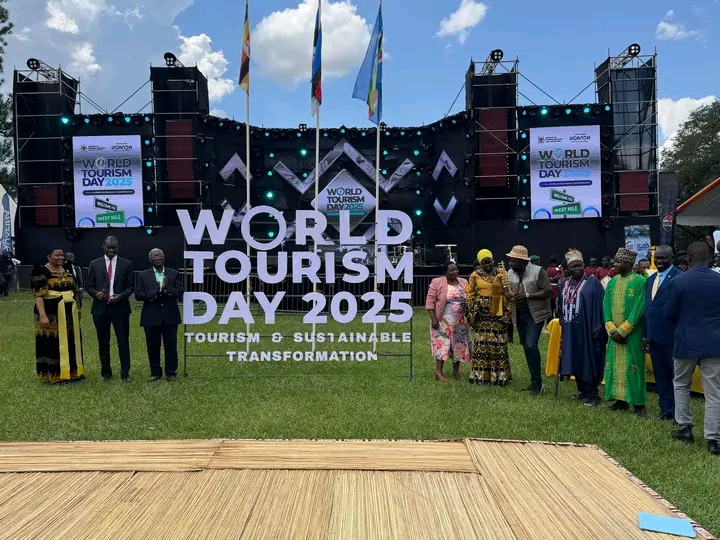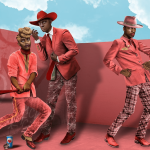The morning light over Arua City arrived soft and golden, spilling over the rolling hills and market stalls as if the sun itself had been invited to celebrate. The golf grounds, usually quiet and green, were already alive with the hum of drums, the laughter of children, and the rustle of traditional fabrics in every color you could imagine.
It was World Tourism Day 2025, and for once, the world had its eyes on West Nile.
The City That Woke Up to a Celebration
Long before the speeches began, the streets of Arua were already dancing. From Ediofe to Oli, youth groups, cultural troupes, and school children marched through the city with banners that read “Tourism and Sustainable Transformation.”
The air smelled of roasted cassava and Nile tilapia; women in bright gomesis waved palm leaves, and boda riders honked rhythmically, turning the morning into a moving carnival.
I joined the crowd as it wound its way toward the Arua Golf Course. Someone handed me a small green ribbon with the words “Save the Rhino” printed in white. It wasn’t just decoration — it was a promise to protect the wild, the land, and the future.
When the Drums Began to Speak
If you have never heard the Agwara dance performed live, it’s hard to describe. The trumpets call like a hundred birds greeting dawn, while the dancers stamp and twist until the earth itself seems to throb beneath their feet.
As the performers from the Lugbara, Alur, and Kakwa communities took the stage, I felt the ground vibrate. Each beat carried stories — of ancestors who crossed the Nile, of warriors who guarded the land, and of farmers who still look to the same stars for rain.
Nearby, young women served millet bread and honey, freshly made by local vendors trained under the Uganda Hotel and Tourism Training Institute. Their smiles said everything: this wasn’t just a performance — it was identity reborn.
Glamour, Sweat, and Spirit
A sudden shout rose from the crowd — Golola Moses had arrived, his grin as wide as ever. Children swarmed around him, posing for photos as he playfully flexed his muscles. Then came the Tourism Queens, led by Jackie Candia and Cindy Bene, their steps graceful and sure, crowns gleaming under the Arua sun.
“Beauty and strength can both sell Uganda,” someone murmured beside me, and I nodded.
Moments later, a drone buzzed overhead. “Marvin the Guide,” a popular travel vlogger, was capturing everything. His clip — “The Queens showed up for #WTD2025 in Arua City” — would later flood X (formerly Twitter) with pride.
When Words Carried Weight
By mid-afternoon, the sun had softened and a gentle breeze moved through the crowd as Prime Minister Robinah Nabbanja took the podium.
“Conserve the environment,” she urged, her voice steady. “Especially the rhinos — they are not just animals, but a symbol of our shared responsibility.”
The applause that followed wasn’t polite; it was thunderous. Even the vendors paused to listen. For once, government and community seemed to breathe in rhythm.
Nearby, a man from Travel Specialist Uganda Expozed, tears in his eyes, whispered, “I drove from Kasese to Arua, and today I feel seen.” Later that night, he would post: “I sneaked behind the tent and cried like a man with joy.”
Arua on the Timeline
By sunset, the celebration had spilled online.
“Cheers to Arua City & the amazing team behind World Tourism Day,” posted Connie The Guide, attaching a radiant selfie.
Another traveler, Quin Namugerwa Shivan, shared: “The World Tourism Day celebrations took me to Arua… and I found beauty in every beat.”
Arua was trending. The world was watching, and West Nile was finally telling its own story — through dance, laughter, and community.
The Treasures Beyond the Stage
As I walked back through the city that evening, I thought of what lay beyond the noise — the quiet majesty of Murchison Falls, the whispers of history at Indriani Fort, the sacred calm of Mount Wati, and the endless Nile flowing past Rhino Camp.
I thought of the craftspeople in Arua Central Market, weaving baskets from palm and hope, of pilgrims kneeling at Ediofe Cathedral, and of rangers restoring Ajai Wildlife Reserve to its ancient glory.
These are not just destinations — they are chapters in West Nile’s living story.
Gold in the Dust
When I asked an elderly man what tourism meant to him, he smiled and said, “It means people will come and know that we exist.”
That sentence stayed with me. Because in the end, tourism is not just travel — it’s recognition. It’s a handshake between communities and the world.
In Arua, I saw that handshake become a dance — between past and future, between heritage and hope.
As night fell and the last drum faded, I looked back at the glowing tents on the hill and thought: Arua didn’t just host the world; it became the story the world will remember.
Epilogue: The Journey Continues
The Ministry of Tourism and Uganda Tourism Board have promised to build on this moment — supporting eco-projects, local artisans, and youth entrepreneurs.
Tourism advocate Martine Andua later said, “If we can make tourism inclusive and accessible, it will change lives. Not just in numbers — but in hearts.”
Maybe that’s the real gold in West Nile — not the land, but the people who keep believing that every dance, every song, and every shared meal is an invitation to the world to come and see what shines here.
And truly, Arua City shined.
This post was created with our nice and easy submission form. Create your post!



